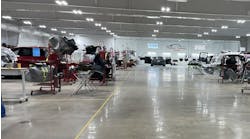The JettaIt all began with a complaint of starting trouble and no air conditioning. In the end, the car overheated, and the customer was looking for someone to pin it on.
A
customer brought in his daughter's 136,000 mile Volkswagen (VW) Jetta and
told us of several problems. The car intermittently would not start, and
the air conditioning (A/C) was inoperative.
After
numerous starting attempts, we were never able to duplicate the starting
problem. We did find the ignition switch sticking at times, so it was
given the WD-40 vaccine. The A/C clutch was cycling rapidly, so the
refrigerant was identified and evacuated. Because we found the Jetta had
lost 9 ounces of refrigerant, we recharged and dyed the system. As is so
common with today's A/C work, no leak was found.
With
the system fully recharged, we discovered that the cooling fans did not
appear to be working correctly. Correction: not working correctly as
"normal operation" would indicate. As typical with Volkswagens,
our service database was very sparse on diagnostic information. There was
no description of the vehicle's cooling fan strategy for engine
temperature or A/C operation. The customer was warned of the overheating
and A/C problem possibilities, and we recommend that he take the vehicle
to a VW dealer to further diagnose and correct that system.
A
week later, the Jetta returned on the back of a tow truck. The car was
still giving the customer "no-start" trouble. Fortunately, the
car was now hung up in "no-start" mode. After testing for power
in various areas, we found that the ignition switch was the cause. During
the ignition switch replacement, the air bag clock spring fell apart.
After a new clock spring and ignition switch, the customer was back on the
road.
play "Pin the Tail on
the Donkey" with you?
Exactly
one month later, the VW was back again - riding the wrecker. Now the
customer was upset. The VW had overheated on the highway. The customer
found that one of the fan blades had broken off. For those of you that
don't know about the wonderful Jetta cooling fan design, this car uses one
cooling fan motor to turn two fan blades. The driver's side fan blade is
attached to the motor. The passengers' side blade is turned by the
driver's side via a skinny fan belt. Guess how you get the fan shroud out?
Evacuate the A/C system again so you can remove the A/C line running above
the fans.
After
a new fan motor, and belt, the Jetta was running again, although not for
long. The cooling system level kept dropping, but there were no visible
leaks. The engine was now difficult to restart hot. A pull of the spark
plugs yielded the rest of the story: coolant in the cylinders. The
customer was notified and came down to take a look.
Ever
have a customer play "Pin the Tail on the Donkey" with you?
Well, this customer tried, but we refused to wear the blindfold. He didn't
get very far trying to pin the overheating problem on us. But we type very
long repair invoices here. Let's just say there was a paragraph or two
about the faulty cooling fans.
The
customer authorized the head gasket repairs, but was fearful about going
to the dealer for the cooling fan diagnosis. A final look by yours truly
yielded some interesting information: Although our VW service information
was useless for any system strategy, it did show the location of the
cooling fan control module. In addition, the customer mentioned that
recently the cooling fans had been on all the time, even on a cold start.
After wiggling several connectors, I lucked out and found one that turned
the fan on and off when moved. It was the rear connector of the cooling
fan module.
(Photos: Mark Giammalvo)
I
was in for a surprise when I disconnected it. Coolant ran out of the
connector and out the bottom of the fan module. Well, I know one general
thing about cooling fan operation. There definitely should not be any
liquids in the control module. Now, how would coolant get into the fan
module? I was wondering if the mounting location of the module had any
bearing on this; after all, it's mounted right under the cooling bottle.
What a great design; it sure guarantees future sales of cooling fan
modules.
A
call to a friend of mine at the VW dealer revealed this to be a common
occurrence. When I asked why European engineering would allow placement of
an electronic module under the overflow bottle, my friend had a comical
reply: "European cars don't overheat." Now that's a funny one!
Needless to say, replacing the module resolved the Jetta's fan troubles. I
even added some duct tape to protect the new module when the car overheats
again. Now the fan had two speeds that came on with hot engine temperature
and with A/C operation.
I've
seen my share of VW issues in my 20 or so years of auto service. The Jetta
window regulator design is really extraordinary. We must have already
replaced 50 of those. Now I hear that VW is finally going to send a
mailing to owners for that problem. I'll never forget the first Jetta
window that fell in on me a few years ago. I was driving a 2000 Jetta VR6
home for the night. When I first got in the car, I put my arm on the
center armrest. Suddenly there was a "ping" as the armrest door
button and spring took off in the car.
The
next morning when I got in the car and started the engine, I could hear
the pounding of the main engine bearings at start up. Then, when powering
down the driver's side window, I heard the window motor run but the window
didn't open. After a brief moment, the window crashed down into the door.
My
last experience was a teenager that purchased a VW Golf from us. When the
kid's father came to pick up the car for him, he told me that his son was
going to college and was studying to be an engineer. I remember wanting to
say, "He's going to need to be an engineer to work on this
thing."
I
just don't know what it is about servicing VWs. They sure can be
"hair-pullers." I know several local service shops that will no
longer service them anymore. Even one of our auto wholesalers refuses to
take them as trade-ins now.
I
will admit though, the Jettas sure do ride nice and tight and the VR6
really does have a lot of power. They are fun to drive, just a little
tricky to work on.




